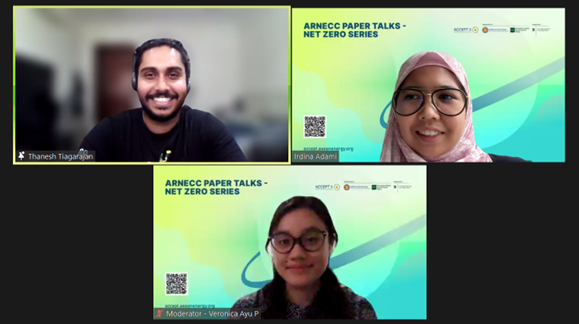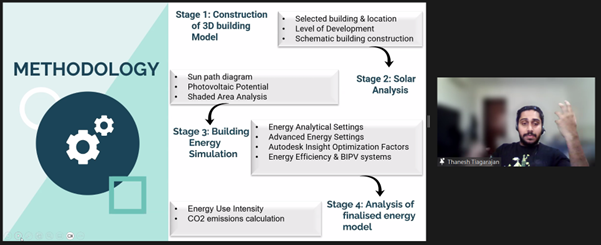i
i
Online, 27 June 2024
The webinar series ‘ARNECC Paper Talks 2.0’ is now eight episodes strong. This monthly virtual discussion series is the flagship activity of the ASEAN Researchers Network on Energy and Climate Change (ARNECC), a knowledge-sharing platform on energy-climate and decarbonisation for members of academia, established by the ASEAN Climate Change and Energy Project (ACCEPT). This Thursday, ACCEPT welcomes Mr. Thanesh Tiagarajan from Samaiden Group Berhad Berhad to present his findings from the newly minted academic paper titled “Integration of BIPV design and energy efficient technologies for low energy building in meeting net zero target” which highlights the addition of building integrated photovoltaics (BIPV) into BIM models as a measure to increase the energy efficiency criteria score in Malaysia’s green building rating tool, the Green Building Index (GBI).

Figure 1. Mr. Thanesh Tiagarajan of Samaiden Solar Holdings Bhd. as the speaker (top left), Irdina Batrisyia from ACCEPT II as Master of Ceremony (top right), and Veronica Ayu Pangestika from the ASEAN Centre for Energy as the moderator (bottom).
The paper was written to address a research gap in the coexistence of energy efficiency measures and BIPV utilisation in buildings. Energy efficiency (EE) has been a chief measure in reducing emissions—the world had set targets in decreasing energy demand, such as ASEAN through its collective target of reducing energy intensity by 30% in 2025—as energy consumption associated with buildings accounts for 24% of ASEAN CO2 emissions in 2019. In the pursuit of fulfilling GBI’s EE criteria which has the subcriteria of using renewable energy (RE), it creates a drive to conduct more research within the dual scope of EE and RE. The exemplary measure of generating more detailed BIM models in turn will aid stakeholders to make a more informed decision in determining what combination of EE and RE measures would suit their best interest in cost-, energy- and sustainability-wise. To achieve so, the metrics evaluated in the paper were energy use intensity (EUI, measured in kWh/m2/y) and CO2 emissions (in MtCO2.e).
Mr. Tiagarajan and co-author Yun Ii Go used a cloud-based work package to model the EUI of an existing building in Penang, Malaysia after incorporating photovoltaic data of the planned BIPV installation. The BIM software used was Autodesk Revit, whereas photovoltaic analysis was done with Autodesk Green Building Studio. It is then followed by identifying energy efficiency optimisation and comparing the calculated CO2 emissions pre- and post-optimisation, using the Autodesk Insight software. Through this workflow, he conveyed that incorporating BIPV systems and optimising energy efficiency measures will lower the building’s EUI from 194 to 140 kWh/m2/y which correlates to a 27.9% reduction in CO2 emissions. This highlights the resourcefulness of BIM models as not only does it provide building analysis relevant for architects and civil engineers but also information on planned energy usage and emissions for mechanical and electrical engineers. Policymakers may also benefit from quantifying the realisation of RE and net zero targets in buildings.

Figure 2. Modelling workflow mentioned in the paper
As for the way forward for BIPV, Mr. Tiagarajan conferred that the declining PV prices should be taken as a momentum by governments to introduce more supportive fiscal policies—notably by improving power purchase agreements—and cut down coal-derived energy usage. More engagements would be needed between governments of ASEAN Member States and business stakeholders to ensure more data-driven analyses in green building design through improving EE and RE metrics. On a final note, Mr. Tiagarajan underscored that before implementing the chosen BIM model, one should further conduct a specific financial and technological assessment in choosing the best BIPV option, in consideration of the abundance of BIPV materials and products available in the market.
(SNF)
Join our ASEAN Researchers Network on Climate Change (ARNECC) by registering yourself here. Become a part of our collaborative efforts to address pressing climate challenges and shape a sustainable future.
Detailed information on ACCEPT II can be found at https://accept.aseanenergy.org/
We welcome any future collaboration, please feel free to contact us at [email protected]